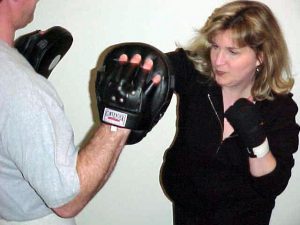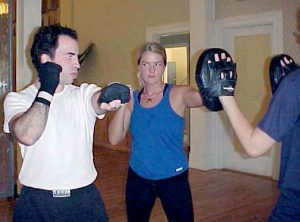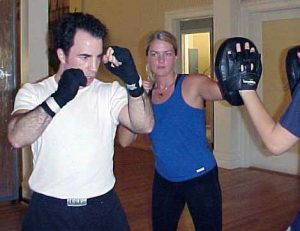Stand-up fighting involves kicking, punching, and close-quarter combatives.
A common saying is “Most fights go to the ground.” True, but most fights start standing up.
UMA’s stand-up curriculum employs kickboxing, Muay Thai, Western boxing, street self-defense and defensive tactics. Instruction will help students develop proper form and, although the training sessions will have some physically demanding components, the instruction will always provide the opportunity to work up to an acceptable level of participation. Students are encouraged to strive to improve the quality of their movement while safely and gradually increasing the number of repetitions they can complete.



This class offers many different interactive drills, flow drills, and sparring. It provides opportunities for you and your partner to train cooperatively or competitively. You spar at the level agreed upon by you and your partner, with the appropriate equipment.

Each session begins with a 10 to 15 minute warm-up.
Stretching, joint mobility, core strengthening, and anaerobic conditioning. Know that any time you increase your fitness level you are improving your ability to defend yourself. You can never be beaten if you can’t be caught, and if you are unconditioned you can be caught.
Unlike style-specific martial arts, the stand-up training at UMA makes a clear correlation between street techniques and boxing & kickboxing techniques. You do not learn one system for historical purposes and then another for modern day self-defense. For us, the negotiating posture is designed to be nearly identical to a boxer’s stance. A finger jab is shown to be similar to a jab punch, a palm heel strike becomes a cross punch, a palm slap to the eardrum has the same body mechanics as a hook punch to the jawbone. Therefore, how you train from day-to-day is how you will be prepared to fight in the event you need to protect yourself.
UMA teaches a variety of practice drills and patterns.
This class often uses focus mitts, Thai pads, and heavy bags. Focus mitts are optimal for working timing and distance. They enable us to test offensive and defensive techniques, and techniques in combination. Stationary and hanging bags allow for full force striking on a piece of equipment representing the body.
Just like constructing a house, we build from the ground up. Students are first taught footwork and basic strikes. Then a wider variety of linear and circular punches & kicks, followed by knees & elbows.

We make time for sparring rounds.
Beginners do not spar until their fundamentals are sound. Mouthguards are mandatory, and can be purchased from the instructor for $1.
Note: although this class focuses on fighting on our feet, it does contain takedowns, grappling, and submissions.